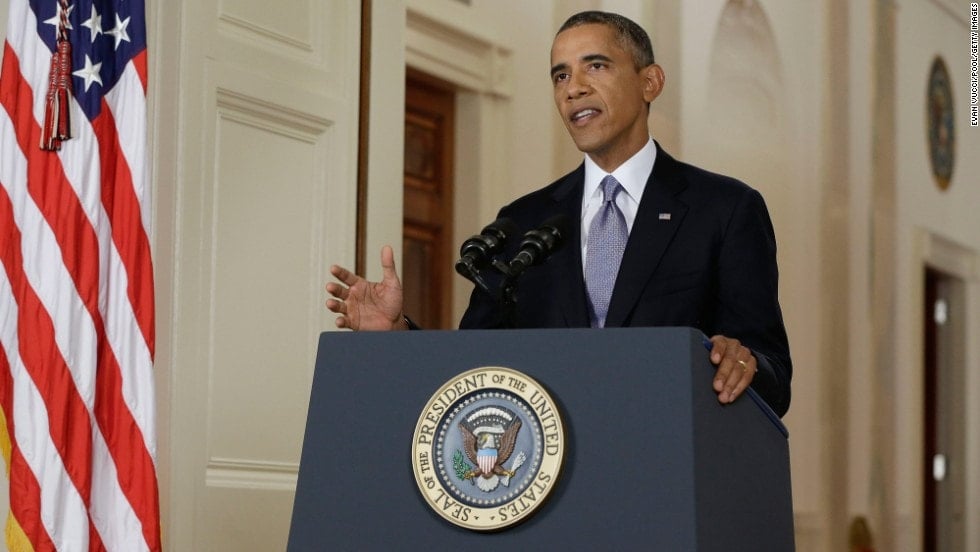The persuasion techniques President Obama effectively used in his speech about Syria changed the minds of millions of Americans.

In CNN’s article, Obama’s Speech A Model of Persuasion, writer David Kusnet disected President Obama’s speech about the change in his military policy towards Syria on September 10, 2013. His article focused on the various persuasion techniques Obama used. Techiques to convince the American public that his policy was the right choice for America.
Kusnet pointed out seven persuasion methods Obama used and when he used them during his speech. There are seven persuasion techniques Kusnet pointed out that Obama used. They are: identifying with the audience, telling a story, bringing it home, invoking the American system, answering questions, offering hopeful news, and appealing to American patriotism.
The Influence of His Speech
According to the article, days prior to the speech up 66% of Americans were against military action in Syria. Afterward, those polled who watched the speech, 61% were in favor of military action. “The poll suggests that he did what presidents rarely do: change people’s minds, if only temporarily,” wrote Kusnet. It appears that President Obama’s persuasive methods were very effective on the audience that viewed his speech.
Obama’s Persuasion Techniques
Identifying with his audience
I thought each point Kusnet made was well back up except for the first one. In his first point, he stated that Obama identified with his audience. He said that Obama’s statements of “resisted calls for military action.” And that “Assad’s government gassed to death over a thousand people” were identifying himself with the audience.
I don’t fully agree that he was identifying with the audience at that moment. This is because the vast majority of us cannot relate to being gassed. I think another part of Obama’s speech would have been better to point out the President identifying with his audience. The moment when he said, “On that terrible night, the world saw in gruesome detail the terrible nature of chemical weapons.” When he says “the world” he is referring to us as well as himself. He connects our feelings with his feelings from viewing the tragic images and video that came out of Syria at that time.
Storytelling
The second persuasion device Obama used that Kusnet pointed out was storytelling. I absolutely agree that the President used storytelling in his speech. Especially when talking about how U.S. soldiers died from being gassed during WWI. Use that device is very effective. Telling a great story transports people’s imaginations into the place you want them to be. According to research, people who are highly engaged in a story a less likely to notice false information. By taking people to a moment American suffered from poisonous gas Obama is able to relate more to those who are suffering from the same thing in another country.
Bringing It Home
The next persuasion method used by Obama in his speech Kusnet called “bringing it home”. Obama’s story about WWII soldiers was a good way to help make the suffering of others more relatable. Even though, it was an event that happened a long time ago. So long ago that no one is alive that experience that war. But then the President brought it home by bringing up the possibility of our current soldiers suffering the same fate. By making that connection Obama raised the concerns of his audience about our current soldiers.
Invoking the American System
Invoking the American system is another tool Kusnet pointed out that Obama leverages in his speech. Though not an official form of persuasion, it can be used to persuade people to join his side. By invoking the American system, Obama is likely to get more people on board. He does this by stating he will wait on congress before he makes any actions. The American people want to see their government collaborate with one another rather than fight each other. Obama appeals to this sentiment by saying he will wait on congress. This will more likely get Republicans to agree with the new position on Syria.
Being president of the United States, Obama will naturally have lots of critics and people questioning his positions and decisions. People in the media accused Obama of being on a slippery slope. That we could end up being a full-on war when he referenced helping the people of Syria. He also showed his opponents that he understands their worries and addressed them. I thought this was a very effective persuasive technique. He used it to get people to feel more comfortable about interfering with the problems in Syria.
Offering Hopeful News
Kusnet also points out that Obama used what he called “offering hopeful news”. I didn’t see how the news of Russia proposing to put pressure on Syria was exactly that helpful and persuasive. Especially given our history with Russia as being complex and frequently not very cooperative. I think Kusnet was reaching some on this point. But to people who deeply about foreign countries involved in our international diplomacy decisions could see it as a positive.
Patriotism
That last persuasive tactic that Kusnet writes that Obama used in his speech is appealing to American patriotism. The President concluded his speech by saying “that’s what makes America different. That’s what makes us exceptional”. This is a strong use of pathos appeal to his audience’s emotions to sway them in his favor. Persuasively appealing to the pathos triggers an emotional response from the audience such as happiness or fear. Leveraging pathos is an extremely effective means of persuading the American people. Especially since most American’s take a lot of pride in the values they hold
David Kusnet’s article broke down Obama’s use of persuasive techniques. He used them in his speech to persuade the American people to help the people of Syria. Though I agreed with most of his points, a couple of them I thought were reaching. Overall I thought Kusnet wrote the article well. It was succinct and supported each persuasion technique Obama used.